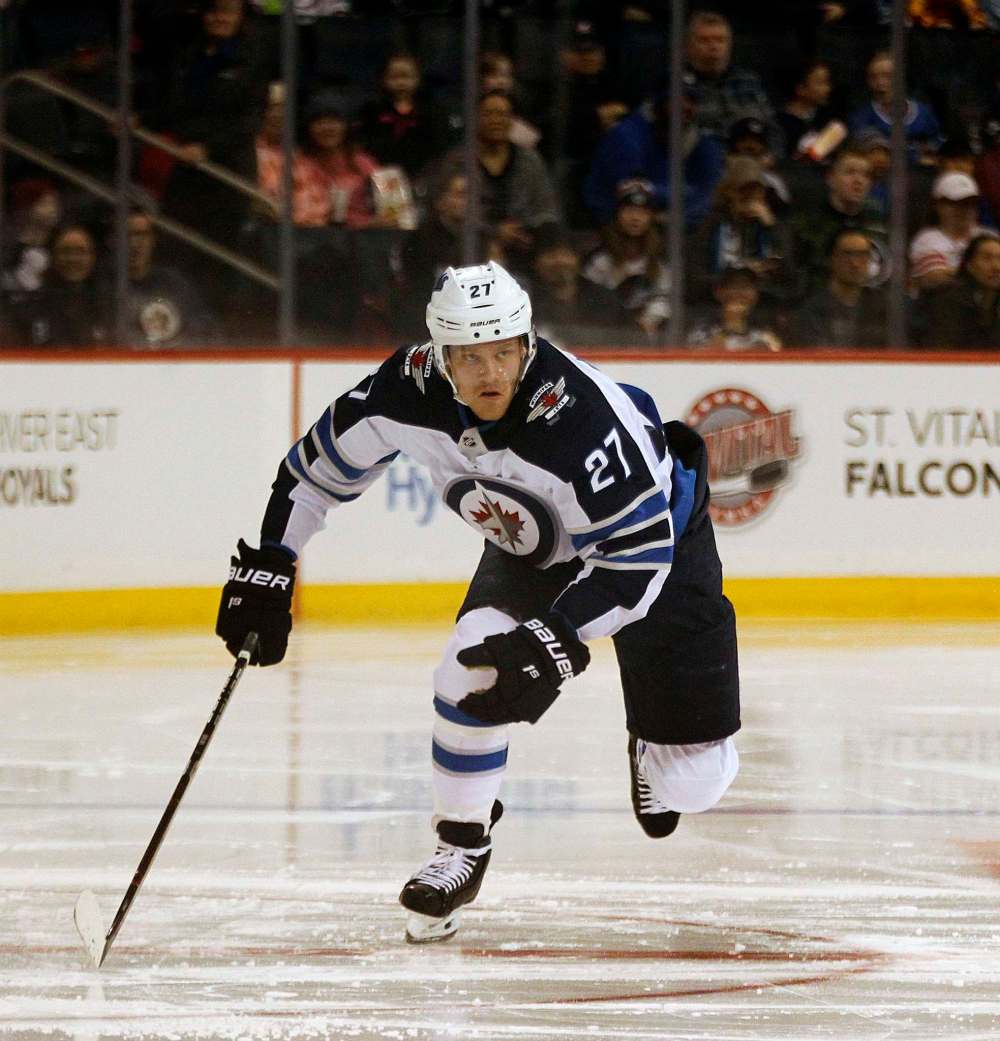Under-powered Jets: Ehlers is missed
Advertisement
Read this article for free:
or
Already have an account? Log in here »
To continue reading, please subscribe:
Monthly Digital Subscription
$0 for the first 4 weeks*
- Enjoy unlimited reading on winnipegfreepress.com
- Read the E-Edition, our digital replica newspaper
- Access News Break, our award-winning app
- Play interactive puzzles
*No charge for 4 weeks then price increases to the regular rate of $19.00 plus GST every four weeks. Offer available to new and qualified returning subscribers only. Cancel any time.
Monthly Digital Subscription
$4.75/week*
- Enjoy unlimited reading on winnipegfreepress.com
- Read the E-Edition, our digital replica newspaper
- Access News Break, our award-winning app
- Play interactive puzzles
*Billed as $19 plus GST every four weeks. Cancel any time.
To continue reading, please subscribe:
Add Free Press access to your Brandon Sun subscription for only an additional
$1 for the first 4 weeks*
*Your next subscription payment will increase by $1.00 and you will be charged $16.99 plus GST for four weeks. After four weeks, your payment will increase to $23.99 plus GST every four weeks.
Read unlimited articles for free today:
or
Already have an account? Log in here »
Hey there, time traveller!
This article was published 30/01/2019 (2501 days ago), so information in it may no longer be current.
I’ve been praising Winnipeg Jets winger Nikolaj Ehlers at length for what may be his most impressive season to date, according to the underlying numbers. Since he was injured in the Jan. 4 game against the Pittsburgh Penguins, his absence has been noticeable.
Prior to Ehlers being sidelined, linemates Blake Wheeler and Mark Scheifele were combining for about 0.47 goals at 5-on-5 every 20 minutes; since he’s been gone, that number has dropped to 0.27.
An 11-game sample isn’t much when we’re talking about goal scoring, which can vary wildly over time, but it’s worthwhile to look at how things have changed for the Jets’ top two forwards. Let’s first examine the differentials the Jets have while Wheeler and Scheifele are on the ice.

!function(e,t,s,i){var n=”InfogramEmbeds”,o=e.getElementsByTagName(“script”)[0],d=/^http:/.test(e.location)?”http:”:”https:”;if(/^/{2}/.test(i)&&(i=d+i),window[n]&&window[n].initialized)window[n].process&&window[n].process();else if(!e.getElementById(s)){var r=e.createElement(“script”);r.async=1,r.id=s,r.src=i,o.parentNode.insertBefore(r,o)}}(document,0,”infogram-async”,”https://e.infogram.com/js/dist/embed-loader-min.js”);
I want to note the numbers on the graph are not a WOWY calculation; meaning the numbers from before Jan. 4 are season-long and include all games Ehlers was in the lineup, no matter the line combinations.
Keeping that in mind, and knowing the top line struggled a bit offensively at the start of the NHL season, the differentials have all dropped considerably since Ehlers was hurt (except for high-danger chances).
Gone is the top line’s ability to control puck possession, but the dominance over puck movement into the slot remains, even after a considerable three-percentage point drop from the earlier heights.
Differentials are a measure of both offensive and defensive results, so while we know the overall play has been less than stellar without Ehlers in the lineup, the differentials don’t tell us where the problem is, or why.
Because we’re talking about a lack of 5-on-5 goals, let’s break down what they are doing individually on offence with Ehlers on the shelf.
Both Scheifele and Wheeler have drastically increased their shot volume from the slot, with big increases specifically in high-danger chances.
Both are also connecting less frequently on passes from the slot, so it appears the focus to compensate for the loss of Ehlers is to crash the net more often, forcing more dangerous chances by shot location, while sacrificing passing plays.
Trading off puck movement for shot location is something that can work, but Winnipeg’s greatest strength as a team is mastery of puck movement in the offensive zone, and preventing that same puck movement in its own zone.
Fortunately, the drop in slot passes for hasn’t hurt the Jets so far, because they’ve coupled it with a bit more focus on their defensive game.
It’s notable the volume of both high-danger chances and passes to the slot have dropped for and against since Ehlers has been out — despite Wheeler and Scheifele specifically increasing their shot volume.
!function(e,t,s,i){var n=”InfogramEmbeds”,o=e.getElementsByTagName(“script”)[0],d=/^http:/.test(e.location)?”http:”:”https:”;if(/^/{2}/.test(i)&&(i=d+i),window[n]&&window[n].initialized)window[n].process&&window[n].process();else if(!e.getElementById(s)){var r=e.createElement(“script”);r.async=1,r.id=s,r.src=i,o.parentNode.insertBefore(r,o)}}(document,0,”infogram-async”,”https://e.infogram.com/js/dist/embed-loader-min.js”);
For example, while Scheifele was on the ice before Jan. 4, there were 5.11 passes to the slot for the Jets per 20 minutes at 5-on-5, and 3.68 against. Those numbers drop to 3.48 and 2.83, respectively, in the time since (with Wheeler posting similar results). That is a drop of almost two slot passes in total per 20 minutes, or a 28 per cent drop in dangerous passes while he’s on the ice.
When the volume of scoring plays goes down, even while maintaining positive percentages, the possibility of a cold streak increases — and that’s what we’re seeing more of (rather than Wheeler and Scheifele not contributing).
In order to get to the peak of how the pair played last season, I think a clamp down on defence is probably a necessary thing for the Jets. Last season, they were a team that played a low volume game in scoring chances, giving up very little but making their own low scoring chance totals much more dangerous with passing plays.
If the Jets can get back to the low volume of chances against they allowed last season while Ehlers is out, and maintain that, while increasing their offensive production with him back in the lineup, they could be the team we all expected to see coming into 2018-19. A scary thought for the rest of the Western Conference.
Andrew Berkshire is a hockey writer specializing in data driven analysis of the game.







